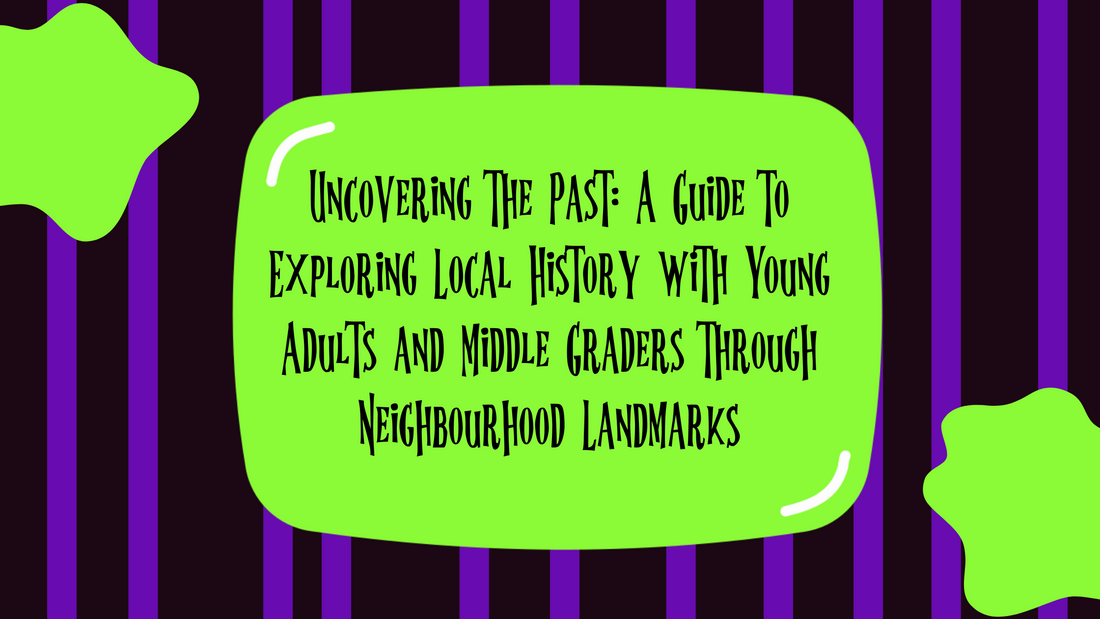As an affiliate, I earn from qualifying purchases, but this doesn't affect the reviews or recommendations—your trust is important to me!
Uncovering the Past: A Guide to Exploring Local History with Young Adults and Middle Graders through Neighbourhood Landmarks

Untold Stories of the Past: A Guide to Local Exploration
Untold stories of the past are etched on every corner of our neighbourhoods, embedded in local landmarks that have withstood the test of time. Imagine yourself as a time traveller as you embark on discovering the past, the less-known tales hidden within the very place you call home.
This Guide: An Invitation to Explore
This guide is specially curated to engage young adults and middle graders in exploring local history by visiting historic landmarks in their neighbourhood. After all, who said history need be confined to classroom textbooks?
Embarking on a Journey of Discovery
Get ready to embark on unique neighbourhood excursions unveiling historical journeys that blend education and adventures seamlessly. This isn't just a local exploration, but a path to understanding how our present has been shaped by our past.
Let's dive in, shall we?
So, how exactly does one go about uncovering the past specifically for young adults and middle graders?
Well, first you need to know where to look. Start your historic adventures at your local libraries. Yes, libraries! They are often a trove of local history—some even housing historic documents and photos that could help delve into the neighbourhood’s past. Outfit your exploratory team with notebooks and cameras, so they can document their own findings, making history both a personal and engaging activity.
Next, move on to historical landmarks in your neighbourhood.
These landmarks often provide a tactile experience that no textbook can compete with. The texture of ancient stones, the echoes in a hundred-year-old hall, or the unforgettable scent of a time-worn cabin could prove to be remarkable memory markers for middle graders learning about their local past. Surrounding the young adults with authentic original artifacts can ignite sparks of curiosity, inspire questions and therefore, deeper understanding.
Your neighbourhood excursions could also incorporate visits to local museums - big or small.
Many museums offer interactive exhibits tailored to engage middle graders in history. These visits not only offer a personal portrayal of the history that has shaped us but also allow young adults to grasp the local history and culture best by presenting the opportunity to touch, play and explore. Being active participants in the learning process boosts this past exploration, transforming it from mundane facts to an adventure that’s both enjoyable and educational.
Remember, exploring neighbourhood history isn't a strictly linear process.
While you can certainly plan your itinerary around key historic points of interest, don’t be afraid to let a little serendipity in. Perhaps an unplanned detour leads you to a hidden mural with ties to a century-old tale or a local resident shares a treasure trove of anecdotal notes about the neighbourhood’s past. This semi-structured local exploration nurtures the sense of discovery in young adults and middle graders. In these moments, history discovery becomes real and personal, leaving an impact that remains far beyond the end of these neighbourhood landmark adventures.
Speaking of personal touches, why not involve your 'history detectives' in creating a local history guide book?
Let them compile the data gathered during the trips to historical landmarks, giving them the liberty to include maps, sketches, photos, notes, and even fictional stories inspired by their findings. This activity not only encourages creativity but also nurtures an appreciation for local history, enabling them to see their neighbourhood in an exciting new light. This could be their reference book for any future quests involving local history or simply a keepsake to remember their historical journey.

25 Recommended Ways to Engage Middle Graders and Young Adults in Exploring Local History
- - Participate in local historical re-enactments
- - Visit local historical landmarks
- - Organize a history-based scavenger hunt in your neighborhood
- - Invite a local historian for a community talk
- - Incorporate local history trivia into game nights
- - Read books based on or set in your local area
- - Start a neighborhood history book club
- - Write and produce a play about a significant event in your local history
- - Visit local museums and interpretive centers
- - Create a local history-focused photo collage
- - Interview older residents about their recollections of the area
- - Conduct a guided tour of historically significant houses in the neighborhood
- - Encourage kids to start a local history blog
- - Plan a drought-resistant garden with plants native to your location
- - Create artworks or monuments inspired by local history
- - Develop a timeline of important events in your community’s history
- - Look at old maps of your town and discuss how it has evolved
- - Make a “time capsule” filled with current items for future generations
- - Volunteer at local historical societies or archives
- - Craft a neighborhood historical walking route
- - Investigate your own home’s history
- - Discuss local indigenous history and cultures
- - Organize a local history fair for the neighborhood kids
- - Create a documentary or short film about local history
- - Design and print a neighborhood history zine

Discovering Our Local History: A Vibrant Journey
As we journey back from the captivating explorations of the past and into the present, remember that history isn't simply about dull, dry facts. It is a vibrant story intricately woven over time, visible all around us in our local neighbourhoods. And the best way to truly comprehend our local history is to engage with it directly.
By visiting historic landmarks, uncovering facts at the local library, and listening to personal stories, we build a much more dynamic, multi-faceted understanding of our historical environment. Let’s continue to nurture the curiosity of our young adults and middle graders, making them active participants in our neighbourhood's historical adventure.
Creating a Personal Memento of History
In creating their own local history guide book, they’ll retain a personal memento of their journey to the past. After all, history can only truly come alive when we seek it out, touch it, breathe it in and experience it for ourselves.
Becoming History Detectives
As history detectives, let's continue to embark on these neighborhood history quests, learning lessons from the past, understanding our present, and shaping our future.
Other Stuff You May Like:
25 Recommended Ways to Engage Middle Graders and Young Adults in Exploring Local History
- - Participate in local historical re-enactments
- - Visit local historical landmarks
- - Organize a history-based scavenger hunt in your neighborhood
- - Invite a local historian for a community talk
- - Incorporate local history trivia into game nights
- - Read books based on or set in your local area
- - Start a neighborhood history book club
- - Write and produce a play about a significant event in your local history
- - Visit local museums and interpretive centers
- - Create a local history-focused photo collage
- - Interview older residents about their recollections of the area
- - Conduct a guided tour of historically significant houses in the neighborhood
- - Encourage kids to start a local history blog
- - Plan a drought-resistant garden with plants native to your location
- - Create artworks or monuments inspired by local history
- - Develop a timeline of important events in your community’s history
- - Look at old maps of your town and discuss how it has evolved
- - Make a “time capsule” filled with current items for future generations
- - Volunteer at local historical societies or archives
- - Craft a neighborhood historical walking route
- - Investigate your own home’s history
- - Discuss local indigenous history and cultures
- - Organize a local history fair for the neighborhood kids
- - Create a documentary or short film about local history
- - Design and print a neighborhood history zine











